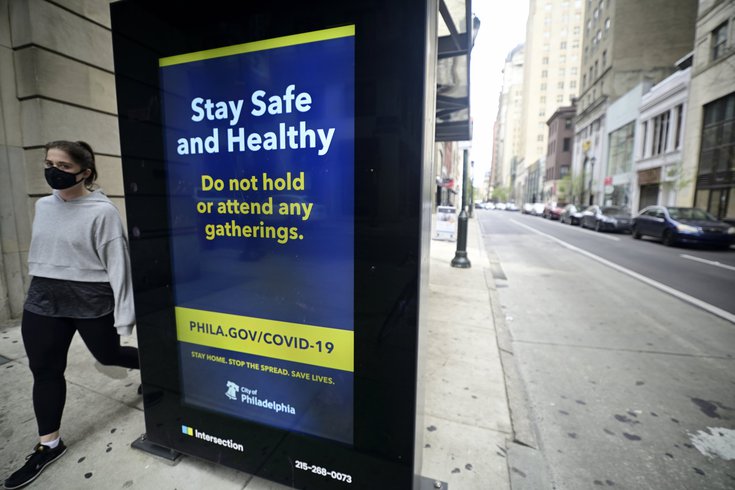
April 23, 2020
 Bastiaan Slabbers/PhillyVoice
Bastiaan Slabbers/PhillyVoice
Pennsylvania counties will reopen by following a three-phase process designed to reboot the economy while limiting new COVID-19 outbreaks, Gov. Tom Wolf announced.
Pennsylvania's northwest and north-central regions will be the first to emerge from the state's most stringent coronavirus-related restrictions.
Gov. Tom Wolf on Wednesday unveiled a step-by-step plan designed to gradually reboot the state's economy and return society to some level of normalcy amid the COVID-19 crisis. The state will be divided into regions, geographic boundaries already in use by the Pennsylvania Department of Health.
Regions individually will progress through three distinct phases of the plan – denoted by the colors red, yellow and green – as they meet criteria, which is mostly based on data related to the number of patients diagnosed with COVID-19 in the area and the rate of new cases.
Restrictions are expected to ease in those first regions on May 8. There is no specific target date for removing them in Philadelphia and the surrounding suburban counties, which are all part of the southeast region and the hardest-hit areas in the state.
State officials will use a tool developed by Carnegie Mellon University in Pittsburgh to determine when move counties to the next phase. They will evaluate the incidence rate of COVID-19 cases per capita, seeking to reduce it to an average of fewer than 50 cases per 100,000 individuals over a 14-day stretch.
The entire state is now in the first phase, or red phase, which aims to minimize the spread of the coronavirus through the measures currently in place – the stay-at-home order, widespread business closures, school closings and strict social distancing guidelines.
The second phase, or yellow phase, eases restrictions on both business and social activities, a strategy state officials say will allow the economy to restart while they closely monitor the impact on public health.
In this stage, stay-at-home orders become less restrictive and businesses can reopen under guidelines issued by the U.S. Centers for Disease Control and Pennsylvania Department of Health. Most limitations on public gatherings remain and restaurants and bars are still restricted to takeout and delivery services.
Third is the green phase. It lifts the stay-at-home and business closings orders entirely. But all businesses and individuals must still follow CDC and health department guidelines.
Here's what each of the three stages entail:
• Only life-sustaining businesses remain open. Congregate care and prison restrictions are in place. Schools and most child care facilities are closed.
• Stay-at-home orders remain active. All large gatherings are prohibited. Restaurants and bars are limited to takeout and delivery services. State officials encourage residents only to travel for life-sustaining purposes.
• State officials will reinforce safety guidelines for businesses, workers, individuals and facilities, updating recommendations whenever necessary. They also will monitor public health indicators and adjust orders and restrictions as needed.
• Businesses must operate via telework whenever feasible. Businesses with in-person operations and child care centers may reopen but must follow safety orders. Congregate care and prison restrictions remain in place. Schools remain closed.
• Stay-at-home orders are replaced by aggressive mitigation orders. Gatherings of 25-plus people remain prohibited. In-person retail sales are permitted, but curbside and delivery services are preferred. Indoor recreation, health and wellness facilities – like gyms and spas – must remain closed, along with entertainment venues, like casinos and theaters. Bars and restaurants are still restricted to takeout and delivery options.
• All businesses are required to follow CDC and state health guidelines for social distancing and cleaning. State officials will continue monitoring public health indicators and adjusting orders and restrictions as needed.
• All businesses are permitted to open and aggressive mitigation orders are lifted, but businesses and individuals are asked to follow CDC and state health guidelines. State officials will continue monitoring public health indicators.
The step-by-step plan follows a general outline released last week. Wolf reiterated that reopening requires adequate supplies of personal protective equipment and diagnostic testing capacity. It also necessitates a monitoring and surveillance program that will enable health officials to swiftly contain new outbreaks.
Extensive details about Pennsylvania's plan to reopen are available on the state's website.
Southeastern Pennsylvania has been under a stay-at-home order since March 23, when Wolf began ramping up restrictions on a county-by-county basis. He placed the entire state under the order on April 1. On Monday, he extended that order until May 8, but emphasized it would be lifted on a regional basis.
Pennsylvania announced another 1,156 COVID-19 cases on Wednesday, brining the state's total to 35,684. There have been 1,622 deaths caused by the coronavirus.